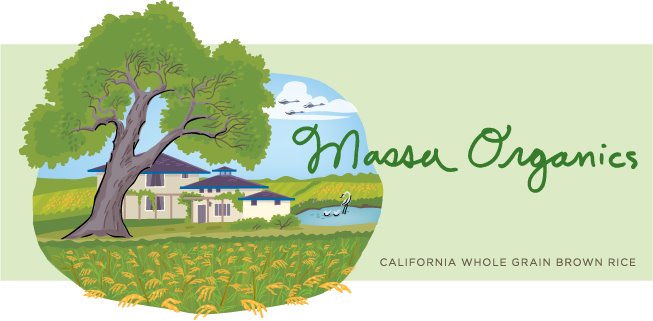Below is an article that was recently published in the
Hartford Courant newspaper. Arancini are really delicious and fun, and our brown rice works every bit as well as the leftover risotto that he calls for in this article. (By the way, our rice makes a fantastic risotto as well!)
At a 2007 fundraiser for CUESA, the organization that runs the Ferry Plaza Farmers Market in San Francisco, Paul Aranstam of Americano Restaurant made Arancini with our rice. Here we are with chef who was serving them:

Need A New Way To Use Leftover Rice? Try Making Arancini
By J.M. HIRSCH | Associated Press
February 19, 2009
Arancini may sound like a species of spider, but they are an incredibly easy and delicious way to use leftover rice.
The term, which is Italian for "little oranges," refers to small balls of rice that are stuffed with cheese or meat (or both), rolled in egg and breadcrumbs or flour, then fried until crisp on the outside and meltingly soft inside.
Arancini traditionally are served as appetizers, especially as bar food, but also would make a fine side. Cubes of mozzarella are the conventional choice for the cheese, but anything that melts well would be fine. Likewise, just about any cooked or cured meat can be used. Roasted chicken, bits of grilled beef or sausage, crumbled bacon or slices of prosciutto all are great.
Here's how it works — no recipe needed.
Because it is so thick and sticky, leftover risotto is best, but just about any rice will do. If using risotto, use your hands to shape about 1/3 cup of it into a bowl in the palm of one hand. Place small pieces of your fillings inside, then cover with a bit more rice and shape into a ball.
If using plain leftover rice, for each cup mix in 1 teaspoon of softened butter and 1 tablespoon grated Parmesan cheese. Microwave for 15 seconds, or enough to just barely melt the cheese and butter to form a sticky rice. Shape the arancini as described above. If you have trouble getting the balls to hold together, you also could mix an egg into the rice.
Once the rice balls are formed, roll them in a lightly beaten egg, then in either all-purpose flour or fine breadcrumbs. In a large, deep skillet over medium-high, heat about 2 inches of vegetable oil to 365 F. A few at a time, fry the rice balls for about 1 minute a side, or until lightly browned all around. Transfer to paper towels to absorb excess oil.
Arancini are best eaten right away. Keep the batches warm in a 200 F oven as you fry others.
If you don't have leftover rice on hand and decide to make some specifically for arancini, consider adding a few strands of saffron, which is a traditional ingredient that gives the rice balls a bright orange color.






















